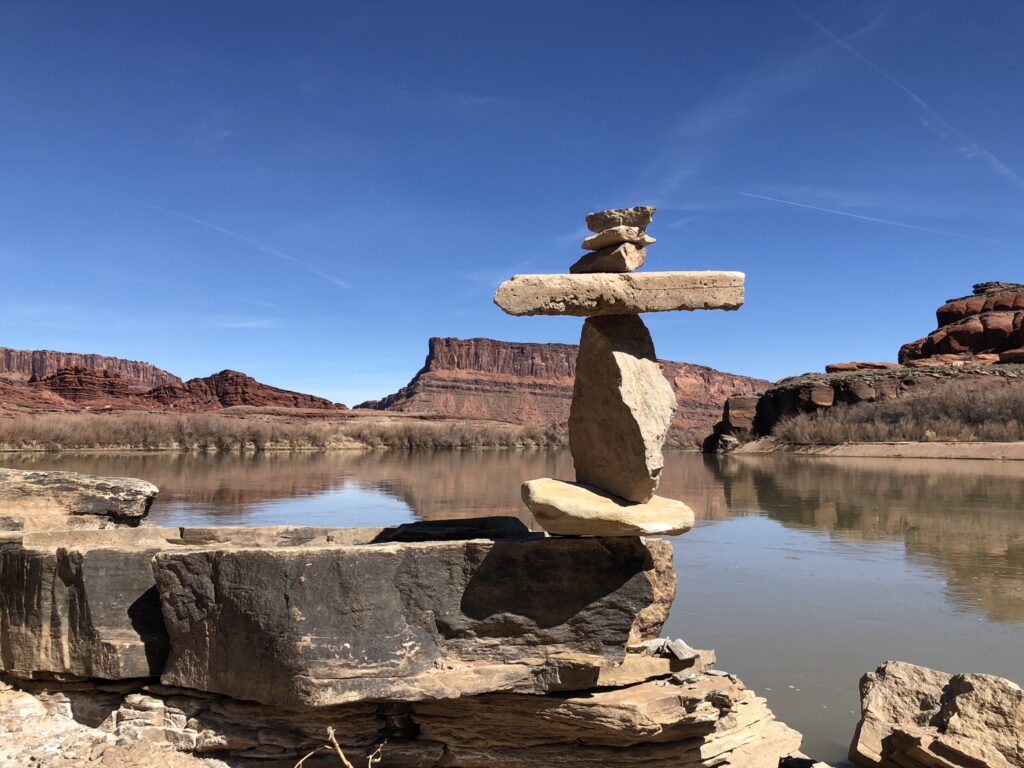
Colorado River, Potash Boat Ramp (downstream from Moab), March 15, 2022. Photo by John Fleck
I’d just turned my bike onto the old potash mine road out of Moab, down the Colorado River, this morning when a friend texted me a picture of a digital readout on a wall that I presume to be deep in the bowels of Glen Canyon Dam:
WATER LEVEL 525
The “3” goes without saying, I guess? The elevation of the Colorado River at the base of Glen Canyon Dam is 3,132 feet above sea level, so the elevation of Lake Powell is always in the 3,000s.
So 3,525 it is.
To my left as I stopped to read the text message, the Colorado River flowed serenely downstream, headed into a gap in the red-rock cliffs, with little apparent care for the affairs of humans.
I’m taking a leisurely few days on my way to Salt Lake City for this week’s Stegner Center symposium on the centennial of the Colorado River Compact, with some extra days for long bike rides on the way up – Sunday on the San Juan through the northeastern edge of the Navajo Nation, today in Moab on the Colorado, and tomorrow a bit of time along the Green – the Colorado River’s three great strands.
I didn’t plan to be in Moab, where the Colorado River enters the Canyon Country of Lake Powell and Glen Canyon Dam, on the day Powell dropped through the arbitrarily magic level of elevation 3,525. You can’t plan stuff like that.
From a young age, all I ever really wanted to do was write about this river. I think I must have been a teenager when, on one of our annual summer car camping expeditions (early 1970s?) my parents bought me Michael Collier’s book An Introduction to Grand Canyon Geology. And I remember not just being interested in the geology, and the Grand Canyon, and the river, but in Collier.
Books are written by people, and I wanted to be one of those people.
Potash Road was a delight, 40-ish miles of out-and-back flat road with an up-canyon tailwind for the ride home. It was in the 30s when I started, but by afternoon I’d peeled the layers down to shorts – first shorts ride of 2022. I took my new bike, which is not really a new bike so much as the latest remodeling job on one of my old bikes done by my friends at Two Wheel Drive.

built for leisure
The new bike is built for leisure, and can handle a bit of dirt.
When the states of the Colorado River Basin were developing their Drought Contingency Plan, they set elevation 3,525 as a soft line, to leave a buffer above the critical elevation of 3,490, which is where Glen Canyon Dam’s power generating gizmos start to get wonky. Even that isn’t a firm line, as Luke Runyon points out.
Cavitation.
Uncharted territory.
In 2019, I wrote a bit of business that’s getting a fresh burst of traffic as Lake Powell enters the great unknown. At the time I wrote it, Lake Powell’s elevation had stabilized after the big crash of the early 21st century, but people were worried:
It certainly would be correct, and is important to note, that a repeat of the drought of the early ’00s would be disastrous. Absent changes in management, it would lead us to dead pool. It is important to have policies in place that are ready for that.
We are, in fact, now in the third year of a “repeat of the drought of the early ’00s”, and beyond the Hail Mary of sending a bunch of water downstream from Flaming Gorge, I don’t see the policies in place that are ready for that.
On my languid bike ride down Potash Road today, I stopped at a particularly memorable pullout to have one of my peanut butter and jelly sandwiches (the “new bike” has panniers, the better to carry large quantities of food, in addition to stashing peeled layers of clothing). The river was low, exposing a sandbar across the way, backed up by a thicket of tamarisk, backed up by what I presume to have been an old Pleistocene bench – ancient deposits of sands and gravels (forgive me, Jack, if I’m mucking up the geomorphological story, I love to say “Pleistocene bench”).
It was a reminder that the river is operating on different time scales than we are, a point I remember Collier’s book making to teenage John in a way that has stuck to this day.

“If you free yourself from the conventional reaction to a quantity like a million years, you free yourself a bit from the boundaries of human time. And then in a way you do not live at all, but in another way you live forever.”
—John McPhee, Basin and Range
Mother Nature works on her own schedule, not ours. The next few decades will be interesting times in the American Southwest.
The West is going to learn a big lesson in the next few decades. One that may or may not teach something to about 40 million people or more in that West. That lesson will either shock their sensibilities into realizing that you can’t live in the desert and still expect to have limitless water available at your every whim. They must adjust or will simply continue as they are now until reality forces them to become another failed experiment in hubris.
Pingback: At CRWUA, inklings of a Colorado River compromise - jfleck at inkstain
Pingback: At #CRWUA2022, inklings of a #ColoradoRiver compromise: "Managing based on inflow" - InkStain @jfleck #COriver #aridification - Coyote Gulch